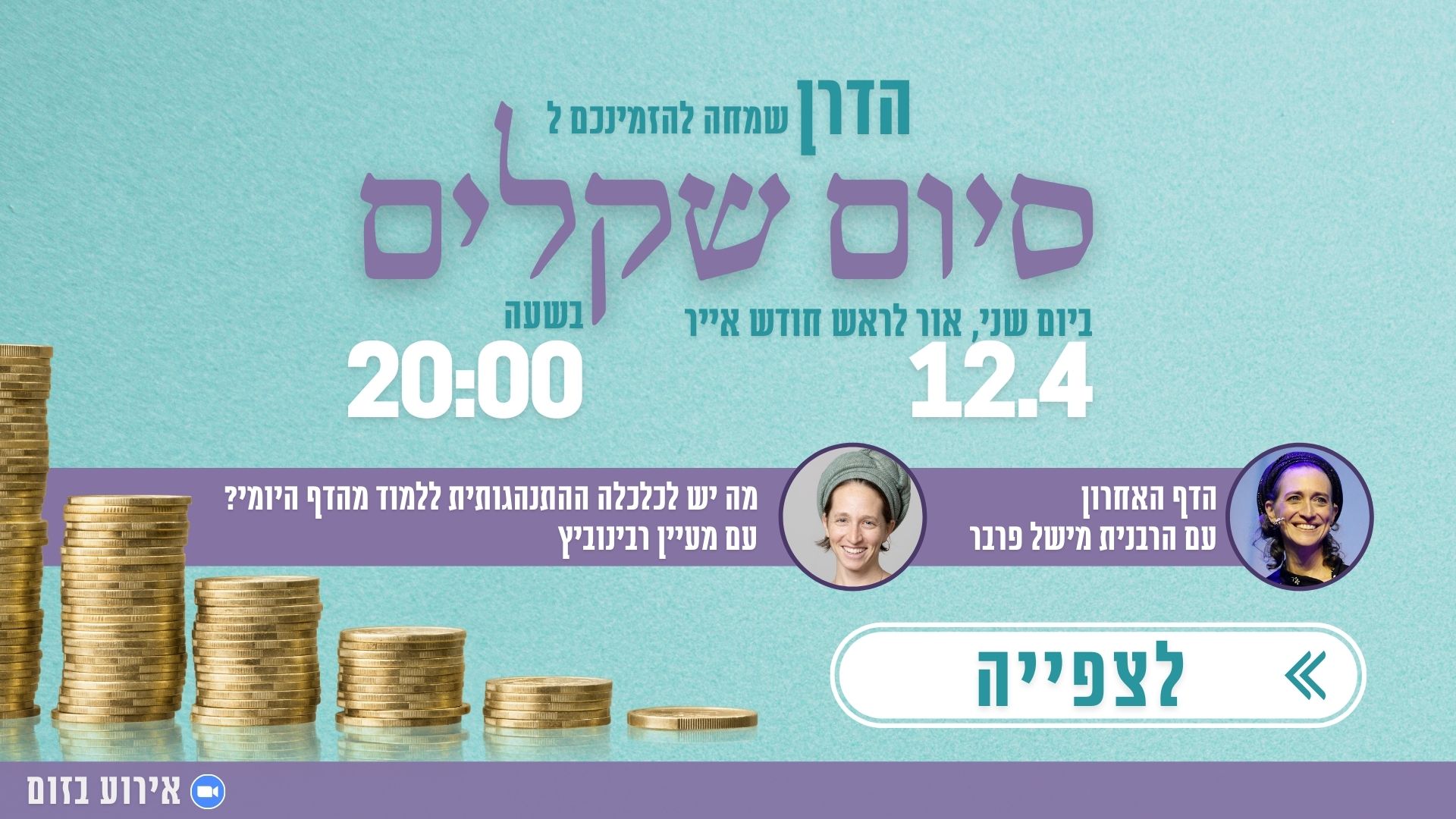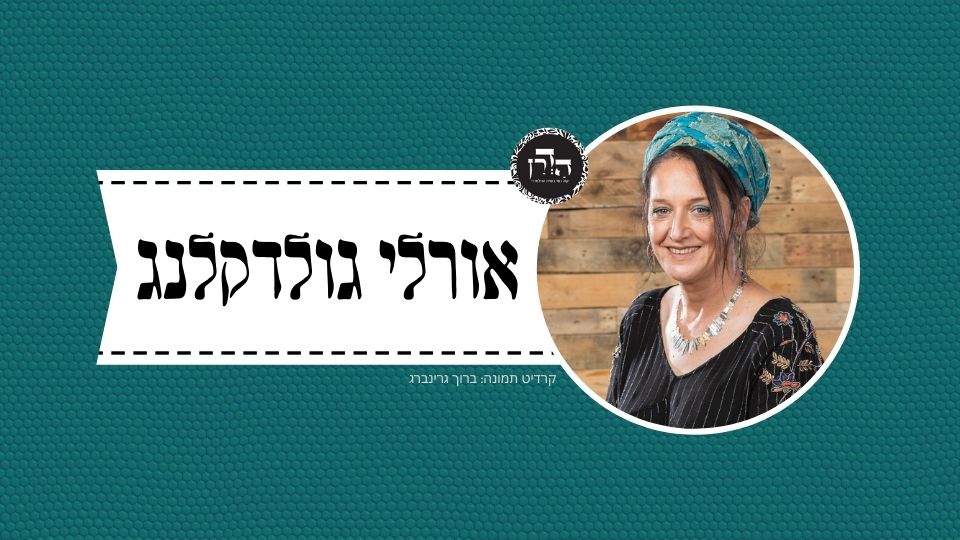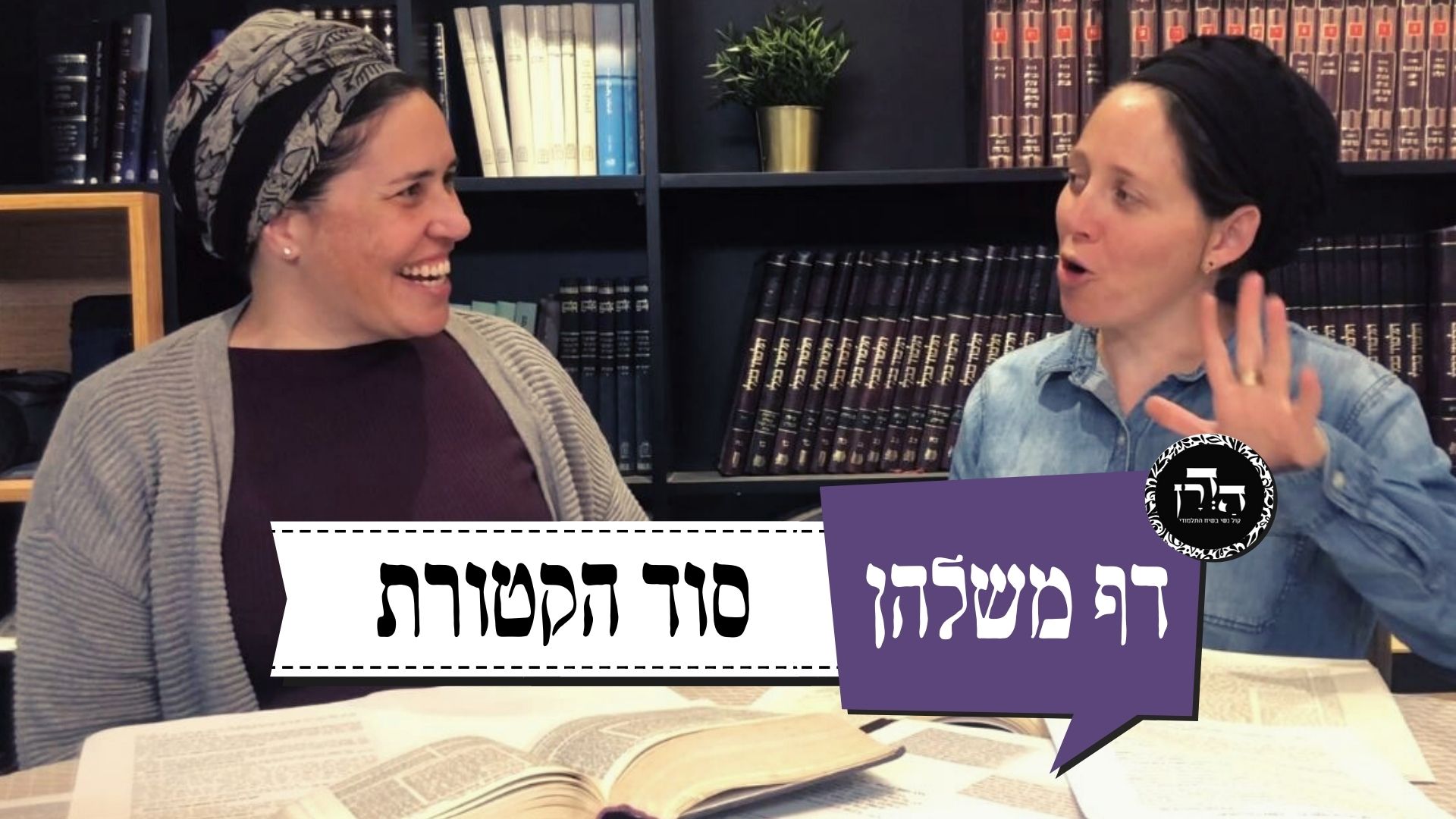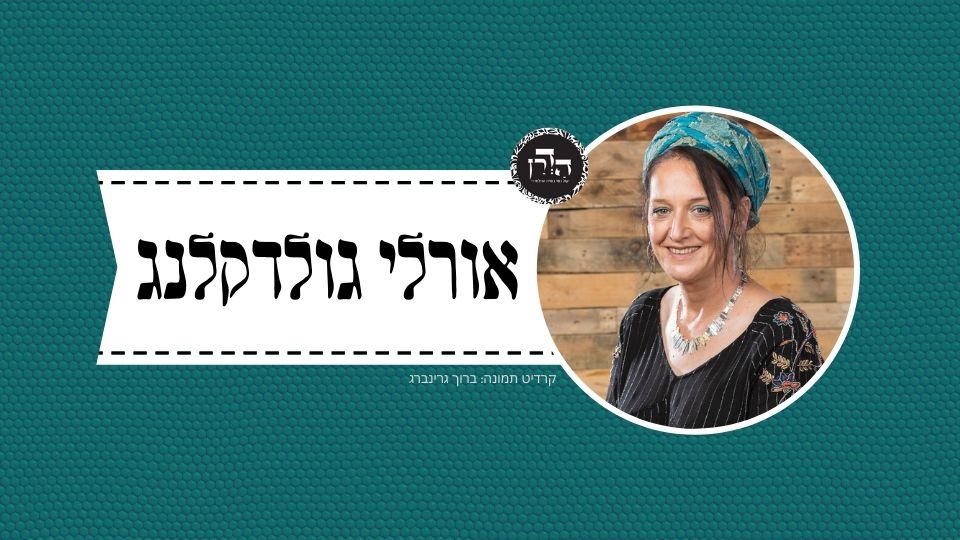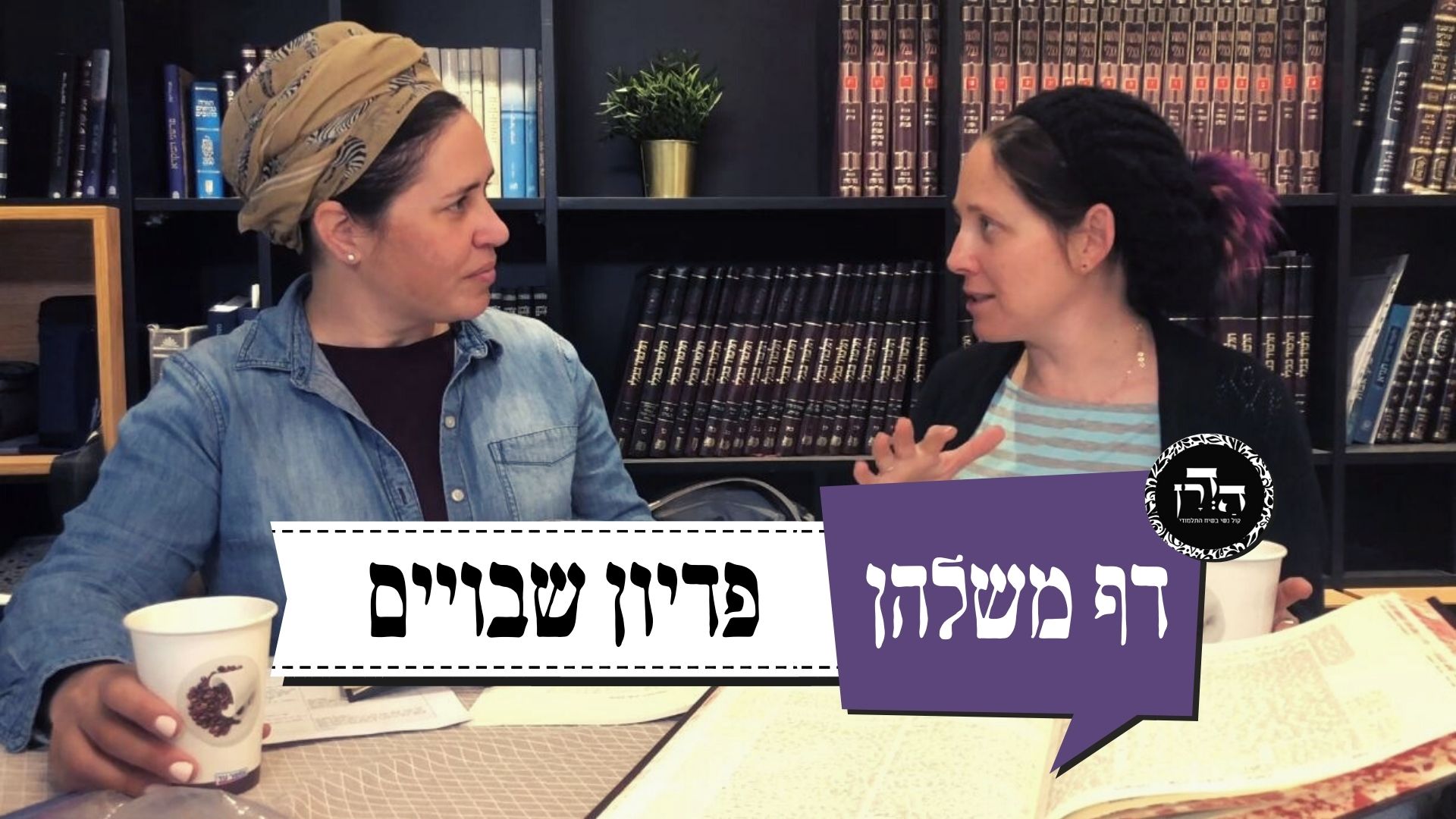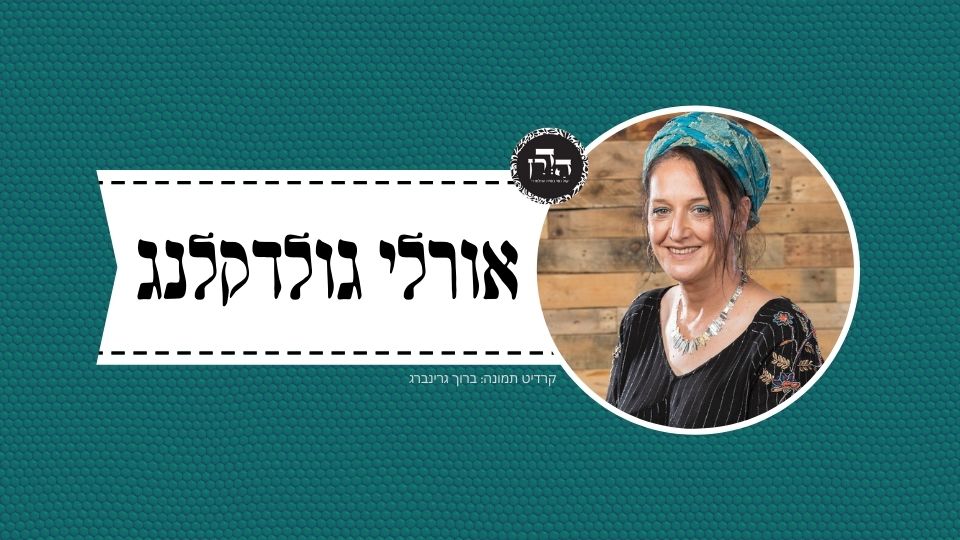שקלים ד
הַתְּרוּמָה מֶה הָיוּ עוֹשִׂין בָּהּ, לוֹקְחִין בָּהּ תְּמִידִין וּמוּסָפִין וְנִסְכֵּיהֶם, הָעֹמֶר וּשְׁתֵּי הַלֶּחֶם וְלֶחֶם הַפָּנִים, וְכָל קָרְבְּנוֹת הַצִּבּוּר. שׁוֹמְרֵי סְפִיחִים בַּשְּׁבִיעִית, נוֹטְלִין שְׂכָרָן מִתְּרוּמַת הַלִּשְׁכָּה. רַבִּי יוֹסֵי אוֹמֵר, (אַף הָרוֹצֶה) מִתְנַדֵּב שׁוֹמֵר חִנָּם. אָמְרוּ לוֹ, אַף אַתָּה אוֹמֵר, שֶׁאֵינָן בָּאִין אֶלָּא מִשֶּׁל צִבּוּר:
At certain times of the year, half-shekels that had been donated to the Temple and stored in a chamber in the Temple were collected in order to be used for various purposes. The mishna asks: The collection of half-shekels, what would they do with it? They would purchase animals for the daily offerings, which were offered each morning and afternoon; and for the additional offerings, which were offered on Shabbat, the New Moon, and Festivals; and wine for their libations; barley for the omer meal-offering; and wheat for both the two loaves offered on Shavuot and the shewbread; and animals for all the communal offerings. § The guards of the sefiḥin, grain that grew without being purposely planted, during the Sabbatical Year, ensured that people did not take this ownerless grain, so that it remained available to be used for the omer and the offering of the two loaves. They collect their wages from the collection of the Temple treasury chamber. Rabbi Yosei says: One who so desires may even volunteer his services and guard the grain as an unpaid bailee. The Rabbis said to him: Even you must say that the omer and the two loaves come only from communal funds and not from any one individual. If one were to volunteer his services, he would acquire the grain for himself by guarding it and transporting it to the Temple. In that case, these offerings would have come from an individual. So that the offerings come solely from communal funds, the guards must receive payment from the half-shekels removed from the chamber.
פָּרָה וְשָׂעִיר הַמִּשְׁתַּלֵּחַ וְלָשׁוֹן שֶׁל זְהוֹרִית, בָּאִין מִתְּרוּמַת הַלִשְׁכָּה. כֶּבֶשׁ פָּרָה, וְכֶבֶשׁ שָׂעִיר הַמִּשְׁתַּלֵּחַ וְלָשׁוֹן שֶׁבֵּין קַרְנָיו, וְאַמַּת הַמַּיִם, וְחוֹמַת הָעִיר וּמִגְדְּלוֹתֶיהָ, וְכָל צָרְכֵי הָעִיר, בָּאִין מִשְּׁיָרֵי הַלִּשְׁכָּה. אַבָּא שָׁאוּל אוֹמֵר, כֶּבֶשׁ פָּרָה כֹּהֲנִים גְּדוֹלִים עוֹשִׂין אוֹתוֹ מִשֶּׁל עַצְמָן:
The red heifer, the scapegoat, and the strip of crimson wool used in the process of burning the red heifer all come from the collection of the Temple treasury chamber, despite the fact that they are not sacrificial offerings. The same is true for the ramp built from the Temple Mount to the location on the Mount of Olives, where they would slaughter the red heifer; the ramp built to lead the scapegoat out of the city; the strip of crimson wool that was tied between its horns; any repairs required for the aqueduct that ran through the Temple courtyard and the walls of the city and its towers; and for all the needs of the city, such as street repairs, security, and the like. All of these come from the remains of the chamber, i.e., from the money that remained in the chamber after the three collections of money were taken to use for communal offerings. Abba Shaul says: The High Priests construct the ramp for the red heifer from their own funds.
מוֹתַר שְׁיָרֵי הַלִּשְׁכָּה מֶה הָיוּ עוֹשִׂין בָּהֶן, לוֹקְחִין בָּהֶן יֵינוֹת, שְׁמָנִים וּסְלָתוֹת, וְהַשָּׂכָר לַהֶקְדֵּשׁ, דִּבְרֵי רַבִּי יִשְׁמָעֵאל. רַבִּי עֲקִיבָא אוֹמֵר, אֵין מִשְׂתַּכְּרִין מִשֶּׁל הֶקְדֵּשׁ וְלֹא מִשֶּׁל עֲנִיִּים:
What would they do with the leftover remains of the chamber after all the items mentioned above had been attended to? They would purchase wine, oil, and fine flour and sell them to those who needed them for their private offerings. And the profit from these sales would go to consecrated property, i.e., to the Temple treasury; this is the statement of Rabbi Yishmael. Rabbi Akiva says: One may not generate profit by selling consecrated property, neither may one profit from funds set aside for the poor.
מוֹתַר תְּרוּמָה מֶה הָיוּ עוֹשִׂין בָּהּ, רִקּוּעֵי זָהָב צִפּוּי לְבֵית קָדְשֵׁי הַקֳּדָשִׁים. רַבִּי יִשְׁמָעֵאל אוֹמֵר, מוֹתַר הַפֵּרוֹת לְקַיִץ הַמִּזְבֵּחַ, וּמוֹתַר הַתְּרוּמָה לִכְלֵי שָׁרֵת. רַבִּי עֲקִיבָא אוֹמֵר, מוֹתַר הַתְּרוּמָה לְקַיִץ הַמִּזְבֵּחַ, וּמוֹתַר נְסָכִים לִכְלֵי שָׁרֵת. רַבִּי חֲנַנְיָא סְגַן הַכֹּהֲנִים אוֹמֵר, מוֹתַר נְסָכִים לְקַיִץ הַמִּזְבֵּחַ, וּמוֹתַר הַתְּרוּמָה לִכְלֵי שָׁרֵת. זֶה וָזֶה לֹא הָיוּ מוֹדִים בַּפֵּרוֹת:
What would they do with the leftover funds of the collection that had not been spent on communal offerings? They would purchase golden plates as a coating for the walls and floor of the Holy of Holies. Rabbi Yishmael says: The leftover produce was used to purchase the repletion of the altar, i.e., burnt-offerings sacrificed at times when the altar was idle. The leftover funds of the collection were used to purchase sacred vessels. Rabbi Akiva says: The leftover funds of the collection were used to purchase the animals used for the repletion of the altar, since they had originally been collected for offerings. The leftover libations were used to purchase sacred vessels. Rabbi Ḥananya, the deputy [segan] High Priest, says: The leftover libations were used to purchase animals for the repletion of the altar, while the leftover funds of the collection were used to purchase sacred vessels. Both this Sage, Rabbi Akiva, and that Sage, Rabbi Ḥananya, did not agree with Rabbi Yishmael’s opinion with regard to the leftover produce.
מוֹתַר הַקְּטֹרֶת מֶה הָיוּ עוֹשִׂין בָּהּ, מַפְרִישִׁין (מִמֶּנָּה) שְׂכַר הָאֻמָּנִין, וּמְחַלְּלִין אוֹתָהּ עַל שְׂכַר הָאֻמָּנִין, וְנוֹתְנִין אוֹתָהּ לָאֻמָּנִין בִּשְׂכָרָן, וְחוֹזְרִין וְלוֹקְחִין אוֹתָהּ מִתְּרוּמָה חֲדָשָׁה. אִם בָּא הֶחָדָשׁ בִּזְמַנּוֹ, לוֹקְחִין אוֹתָהּ מִתְּרוּמָה חֲדָשָׁה. וְאִם לָאו מִן הַיְּשָׁנָה:
The leftover incense from one year could not be used the following year, as it had been purchased with the shekels collected for the previous year. What would be done with it in order to make it usable? The Temple treasurers would set aside an amount of it equal to the value of the wages of the artisans who worked in the Temple. They would then desacralize that incense by transferring its sanctity to the money owed to the artisans. They would then give the incense to the artisans as their wages. Finally, they would return and buy back the incense from the artisans with funds from the new collection of shekels. If the new funds come on time, i.e., by the beginning of Nisan, they purchase the incense with funds from the new collection of shekels. And if not, they may still purchase it from the old collection, and it is valid.
הַמַּקְדִּישׁ נְכָסָיו וְהָיוּ בָּהֶן דְּבָרִים רְאוּיִין לְקָרְבְּנוֹת הַצִּבּוּר, יִנָּתְנוּ לָאֻמָּנִין בִּשְׂכָרָן, דִּבְרֵי רַבִּי עֲקִיבָא. אָמַר לוֹ בֶּן עֲזַאי, אֵינָהּ הִיא הַמִּדָּה, אֶלָּא מַפְרִישִׁין מֵהֶן שְׂכַר הָאֻמָּנִין, וּמְחַלְּלִין אוֹתָן עַל מָעוֹת הָאֻמָּנִין, וְנוֹתְנִין אוֹתָן לָאֻמָּנִין בִּשְׂכָרָן, וְחוֹזְרִין וְלוֹקְחִין אוֹתָן מִתְּרוּמָה חֲדָשָׁה:
One who consecrates all his possessions without specifying for what purpose, his possessions are consecrated for Temple maintenance. And if among them there are items that are suitable for use as communal offerings, which may not be used for the maintenance of the Temple but only for sacrificial purposes, what is done with those items to remove their consecration for Temple maintenance, in order that they may be reconsecrated for sacrificial use? They are given to Temple artisans as their wages, and thereby they are desacralized; this is the statement of Rabbi Akiva. Ben Azzai said to him: This is not the method to be used. Rather, the same method that is used to desacralize the leftover incense, as is described in the previous mishna, should also be used here, i.e., they set aside from the consecrated items the equivalent of the value owed to the artisans for their wages, and they desacralize them by transferring their sanctity onto the money allocated for the artisans’ wages, and then they give those items, which are no longer consecrated, to the artisans as their wages. According to both opinions, once the desacralized items are in the possession of the artisans, one of Temple treasurers should repurchase those items using money from that year’s new collection of half-shekels, consecrating them for sacrificial use during the coming year.
הַמַּקְדִּישׁ נְכָסָיו וְהָיְתָה בָּהֶן בְּהֵמָה רְאוּיָה לְגַבֵּי הַמִּזְבֵּחַ, זְכָרִים וּנְקֵבוֹת, רַבִּי אֱלִיעֶזֶר אוֹמֵר, זְכָרִים יִמָּכְרוּ לְצָרְכֵי עוֹלוֹת, וּנְקֵבוֹת יִמָּכְרוּ לְצָרְכֵי זִבְחֵי שְׁלָמִים, וּדְמֵיהֶן יִפְּלוּ עִם שְׁאָר נְכָסִים לְבֶדֶק הַבָּיִת. רַבִּי יְהוֹשֻׁעַ אוֹמֵר, זְכָרִים עַצְמָן יִקָּרְבוּ עוֹלוֹת, וּנְקֵבוֹת יִמָּכְרוּ לְצָרְכֵי זִבְחֵי שְׁלָמִים, וְיָבִיא בִּדְמֵיהֶן עוֹלוֹת, וּשְׁאָר נְכָסִים יִפְּלוּ לְבֶדֶק הַבָּיִת. רַבִּי עֲקִיבָא אוֹמֵר, רוֹאֶה אֲנִי אֶת דִּבְרֵי רַבִּי אֱלִיעֶזֶר מִדִּבְרֵי רַבִּי יְהוֹשֻׁעַ, שֶׁרַבִּי אֱלִיעֶזֶר הִשְׁוָה אֶת מִדָּתוֹ, וְרַבִּי יְהוֹשֻׁעַ חָלַק. אָמַר רַבִּי פַּפְּיַס, שָׁמַעְתִּי כְּדִבְרֵי שְׁנֵיהֶן, שֶׁהַמַּקְדִּישׁ בְּפֵרוּשׁ, כְּדִבְרֵי רַבִּי אֱלִיעֶזֶר. וְהַמַּקְדִּישׁ סְתָם, כְּדִבְרֵי רַבִּי יְהוֹשֻׁעַ:
In the case of one who consecrates all his possessions without specifying for what purpose, and among them there is an animal that is suitable to be sacrificed on the altar, male or female, what should be done with it? Rabbi Eliezer says: Since he did not specify otherwise, everything is consecrated for Temple maintenance. Therefore, any males should be sold for the needs of burnt-offerings, i.e., to individuals who will sacrifice them as such. And any females, since they cannot be brought as burnt-offerings, should be sold for the needs of peace-offerings, i.e., to individuals who will sacrifice them as such. And their monetary value that is received from their sale is allocated with the rest of his property for Temple maintenance. Rabbi Yehoshua says: Although he did not specify for what purpose he consecrated his possessions, it may be assumed that he intended the animals to be consecrated as burnt-offerings. Therefore, any males should themselves be sacrificed as burnt-offerings, and any females, since they cannot be brought as burnt-offerings, should be sold for the needs of peace-offerings, i.e., to individuals who will sacrifice them as such, and their monetary value that is received from their sale should be used to purchase and bring burnt-offerings. According to both opinions, the rest of the possessions, which are not suitable for sacrificial use, are allocated for Temple maintenance. Rabbi Akiva said: I see the statement of Rabbi Eliezer as more correct than the statement of Rabbi Yehoshua, since Rabbi Eliezer applied his method equally to both animals and other possessions in treating both as consecrated for Temple maintenance, whereas Rabbi Yehoshua made a distinction between them. Rabbi Papeyyas said: I heard the statements of both of them applied to different situations: One who consecrates all his possessions and explicitly states that his animals are to be included, clearly intends to equate his animals with the rest of his possessions, that both should be consecrated for the same purpose, i.e., for Temple maintenance. Therefore, he should act in accordance with the statement of Rabbi Eliezer. However, with regard to one who consecrates all his possessions without explicitly specifying that this includes his animals, since there is no reason to presume that he wishes them all to be consecrated for the same purpose, it is presumed that each item is consecrated for the purpose most suited to it. Therefore, he should act in accordance with the statement of Rabbi Yehoshua.
הַמַּקְדִּישׁ נְכָסִים וְהָיוּ בָּהֶן דְּבָרִים רְאוּיִין עַל גַּבֵּי הַמִּזְבֵּחַ, יֵינוֹת, שְׁמָנִים וְעוֹפוֹת, רַבִּי אֶלְעָזָר אוֹמֵר, יִמָּכְרוּ לְצָרְכֵי אוֹתוֹ הַמִּין וְיָבִיא בִּדְמֵיהֶן עוֹלוֹת, וּשְׁאָר נְכָסִים יִפְּלוּ לְבֶדֶק הַבָּיִת:
In the case of one who consecrates all his possessions, and among them there were items that are suitable to be sacrificed on the altar, such as wines for libations, and oils for meal-offerings, and birds, e.g., turtledoves or young pigeons, Rabbi Eliezer says: They are sold for the needs of that kind of item, i.e., to individuals who will use them as such. And he should bring with their monetary value that is received from their sale burnt-offerings. And the rest of the possessions are allocated for Temple maintenance.
אַחַת לִשְׁלשִׁים יוֹם, מְשַׁעֲרִין אֶת הַלִּשְׁכָּה. כָּל הַמְקַבֵּל עָלָיו לְסַפֵּק סְלָתוֹת מֵאַרְבַּע, עָמְדוּ מִשָּׁלשׁ, יְסַפֵּק מֵאַרְבַּע. מִשָּׁלשׁ וְעָמְדוּ מֵאַרְבַּע, יְסַפֵּק מֵאַרְבַּע, שֶׁיַּד הֶקְדֵּשׁ עַל הָעֶלְיוֹנָה. וְאִם הִתְלִיעָה סֹלֶת, הִתְלִיעָה לוֹ. וְאִם הֶחְמִיץ יַיִן, הֶחְמִיץ לוֹ. וְאֵינוֹ מְקַבֵּל אֶת מְעוֹתָיו, עַד שֶׁיְּהֵא הַמִּזְבֵּחַ מְרַצֶּה:
Once every thirty days, the prices at which the Temple supplies such as wine, flour, or oil will be purchased are set for the Temple chamber. This set price is implemented in the following way: Any merchant who undertakes to provide fine flour after the chamber set a price of four se’a per sela, even if the general market price rose and stood at three se’a per sela, he must provide fine flour based on the set price of four se’a per sela. However, if the chamber’s set price was three se’a per sela, and the general market price fell to four se’a per sela, he must now provide fine flour based on the new market price of four se’a per sela. This is in order that the Temple treasury of consecrated property always has the upper hand. If the fine flour became wormy, it became wormy for the merchant, i.e., he bears the loss of the ruined fine flour and must provide new fine flour in its place. Similarly, if the wine turned to vinegar, it turned to vinegar for the merchant. This is because the merchant only receives, i.e., earns, his money once the altar is satisfied, i.e., the transaction is only realized once the items have been sacrificed on the altar.

